warning CADILLAC DEVILLE 1996 7.G User Guide
[x] Cancel search | Manufacturer: CADILLAC, Model Year: 1996, Model line: DEVILLE, Model: CADILLAC DEVILLE 1996 7.GPages: 354, PDF Size: 20.32 MB
Page 131 of 354
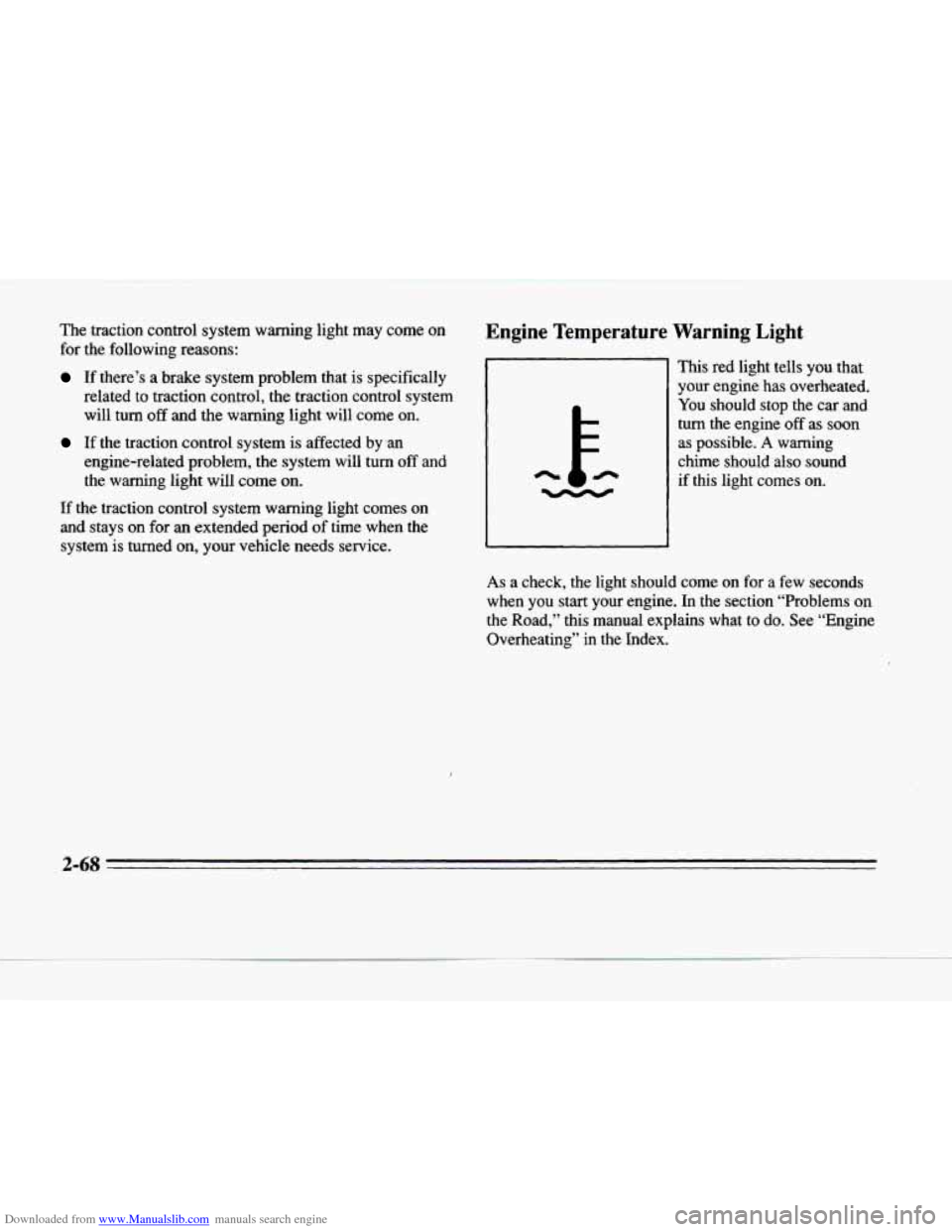
Downloaded from www.Manualslib.com manuals search engine The traction control system warning light may come on for the following reasons:
If there’s a brake system problem that is specifically
related to traction control, the traction control system
will
turn off and the warning light will come on.
engine-related problem, the system will
turn off and
the warning light will come
on.
If the traction control system is affected by .an
If the traction control system warning light comes on
and stays on for an extended period of time when the
system is turned
on, your vehicle needs service.
Engine Temperature Warning Light
This red light tells you that
your engine has overheated.
You should stop the car
and
turn the engine off as soon
as possible. A warning
chime should also sound if this light comes on.
As a check, the light should come on for a few seconds
when you start your engine. In the section “Problems on
the Road,” this
manual explains what to do. See “Engine
Overheating” in the Index.
-.
*’ -.
2-68
Page 137 of 354
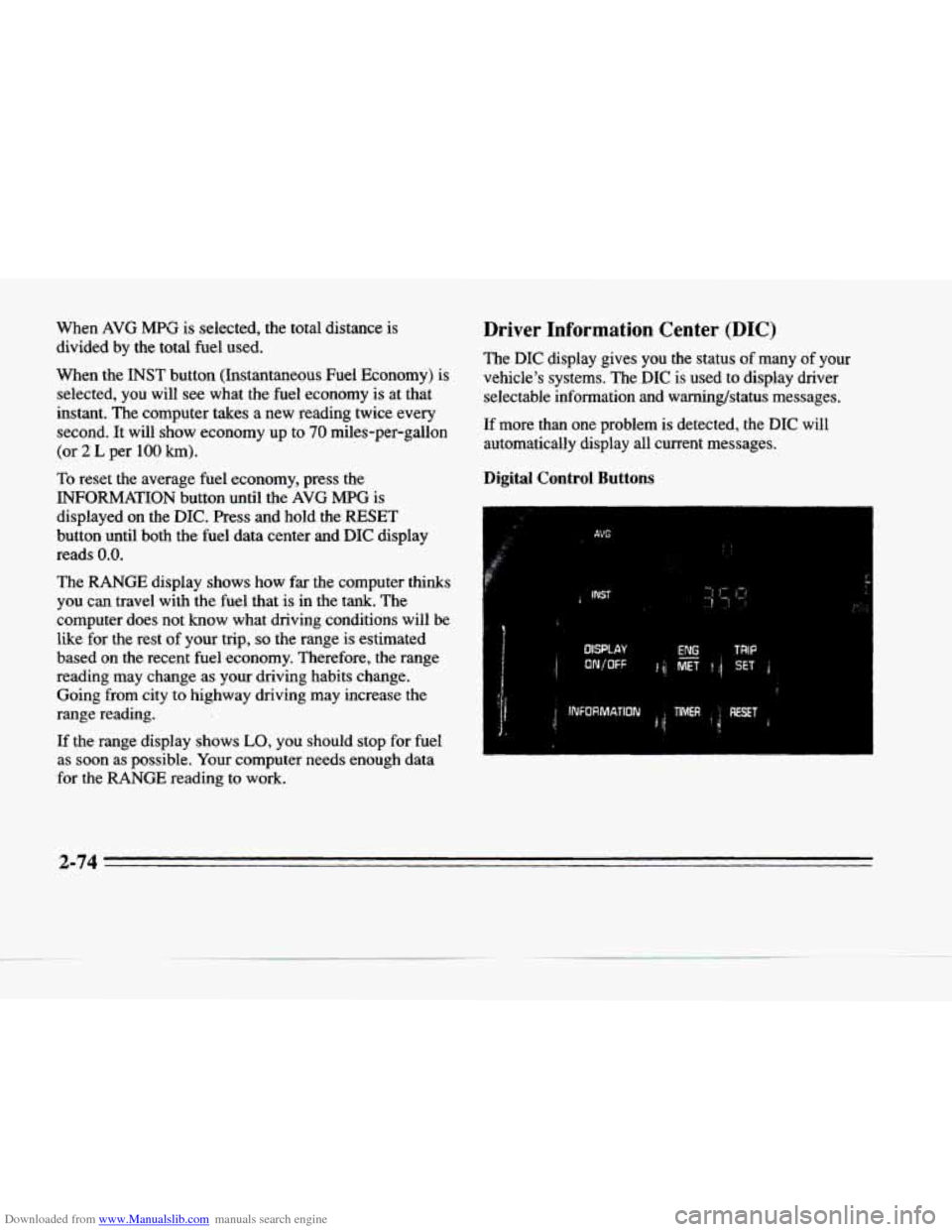
Downloaded from www.Manualslib.com manuals search engine When AVG MPG is selected, the total distance is
divided by the total fuel used.
When the INST button (Instantaneous Fuel Economy)
is
selected, you will see what the fuel economy is at that
instant. The computer takes a new reading twice every second. It will show economy up to
70 miles-per-gallon
(or
2 L per 100 km).
To reset the average fuel economy, press the
INFORMATION button until the AVG MPG is
displayed on the
DIC. Press and hold the RESET
button until both the fuel data center and DIC display
reads
0.0.
The RANGE display shows how far the computer thinks
you can travel with the fuel that is in the tank. The
computer does not
know what driving conditions will be
like for the rest of your trip, so the range is estimated
based on the recent fuel economy. Therefore, the range
reading may change as your driving habits change.
Going from city to highway driving may increase the
range reading.
If the range display shows
LO, you should stop for fuel
as
soon as possible. Your computer needs enough data
for the
RANGE reading to work.
Driver Information Center (DIC)
The DIC display gives you the status of many of your
vehicle's systems. The
DIC is used to display driver
selectable information and warning/status messages.
If more than one problem is detected, the
DIC will
automatically display all current messages.
Digital Control Buttons
i
I
c
2-74
Page 138 of 354
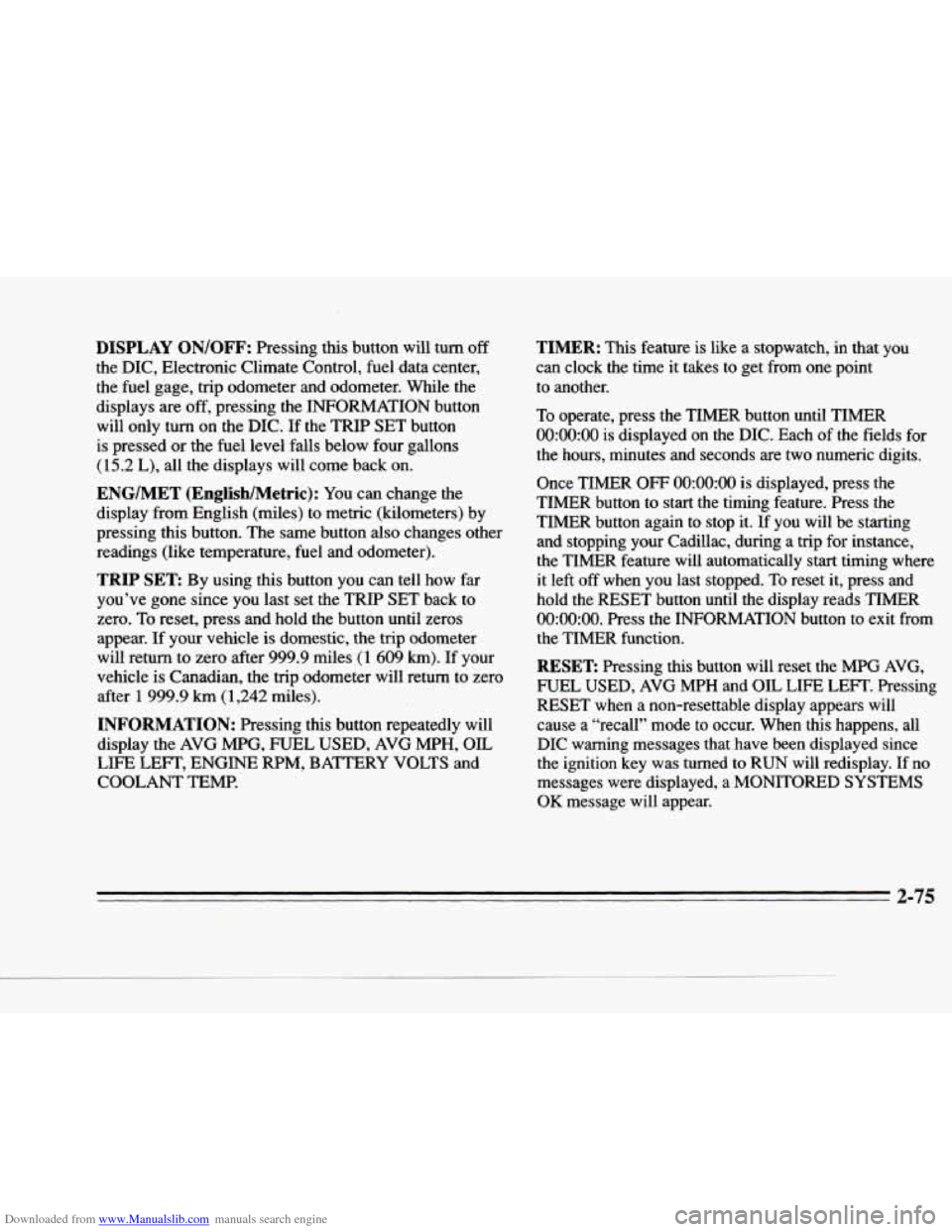
Downloaded from www.Manualslib.com manuals search engine c
c-
rc
Ir
.-
c
DISPLAY ONIOFF: Pressing this button will turn off
the DIC, Electronic Climate Control, fuel data center, the fuel gage, trip odometer and odometer. While the
displays
are off, pressing the INFORMATION button
will only turn on the DIC. If the TRIP SET button
is pressed or the fuel level falls below four gallons
(15.2 L), all the displays will come back on.
ENG/MET (EnglishMetric): You can change the
display from English (miles) to metric (kilometers) by
pressing this button. The same button also changes other
readings (like temperature, fuel and odometer).
TRIP SET By using this button you can tell how far
you’ve gone since you last set the TRIP SET back to
zero.
To reset, press and hold the button until zeros
appear. If your vehicle
is domestic, the trip odometer
will return to zero after 999.9 miles
(1 609 km). If your
vehicle
is Canadian, the trip odometer will return to zero
after
1 999.9 km (1,242 miles).
INFORMATION: Pressing this button repeatedly will
display the AVG
MPG, FUEL USED, AVG MPH, OIL
LIFE LEFT, ENGINE RPM, BATTERY VOLTS and
COOLANT TEMP.
TIMER: This feature is like a stopwatch, in that you
can clock the time it takes to get from one point
to another.
To operate, press the TIMER button until TIMER
0O:OO:OO is displayed on the DIC. Each of the fields for
the hours, minutes and seconds are
two numeric digits.
Once TIMER
OFF 0O:OO:OO is displayed, press the
TIMER button to start the timing feature. Press the
TIMER button again to stop
it, If you will be starting
and stopping
your Cadillac, during a trip for instance,
the TIMER feature will automatically
start timing where
it left off when you last stopped. To reset it, press and
hold the RESET button until the display reads TIMER
0O:OO:OO. Press the INFORMATION button to exit from
the TIMER function.
RESET Pressing this button will reset the MPG AVG,
FUEL USED, AVG MPH and OIL LIFE LEFT. Pressing
RESET when a non-resettable display appears will
cause
a “recall” mode to occur. When this happens, all
DIC warning messages that have been displayed since
the ignition key was turned to RUN will redisplay.
If no
messages were displayed, a MONITORED SYSTEMS
OK message will appear.
2-75
Page 140 of 354
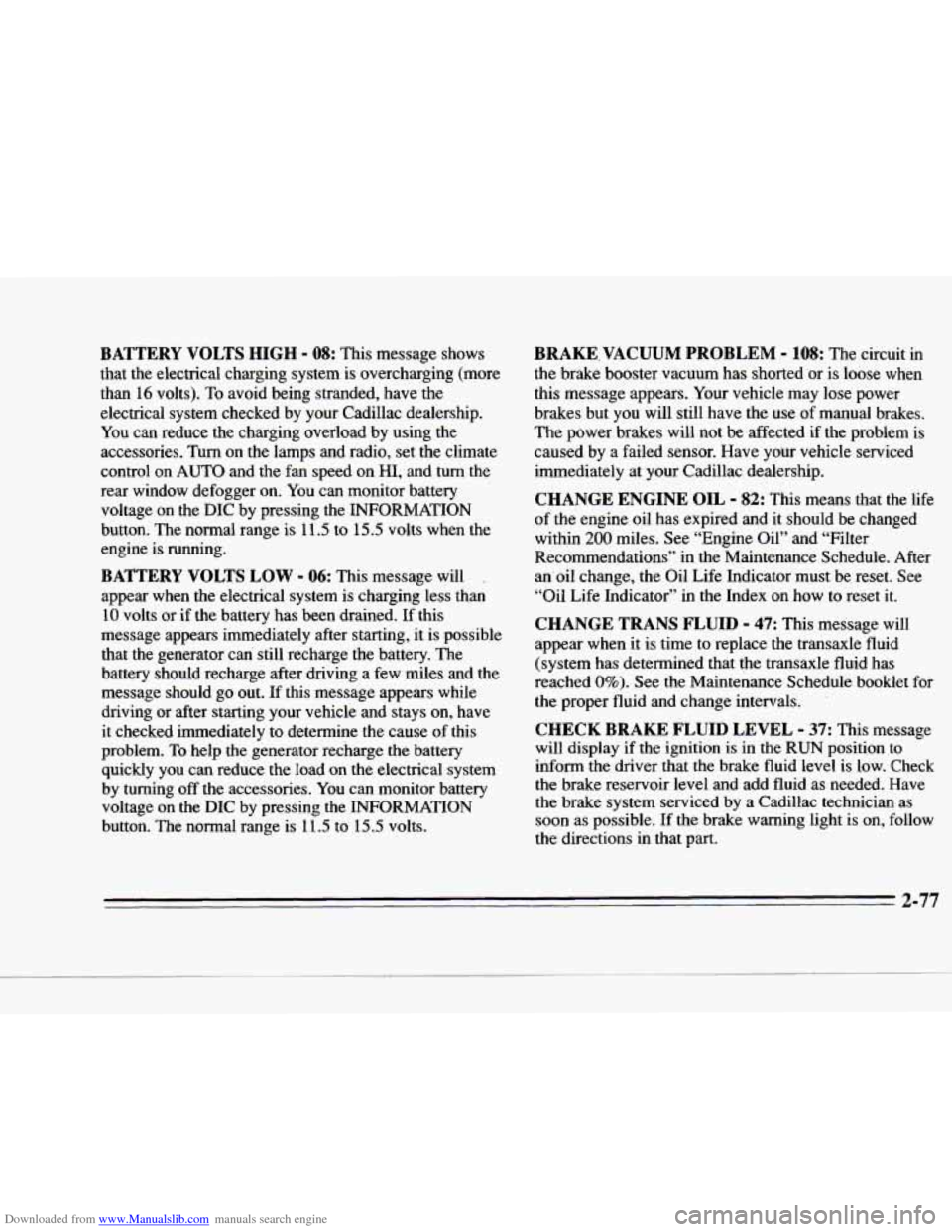
Downloaded from www.Manualslib.com manuals search engine c
I-
BATTERY VOLTS HIGH - 08: This message shows
that the electrical charging system is overcharging (more
than
16 volts). To avoid being stranded, have the
electrical system checked by your Cadillac dealership.
You can reduce the charging overload by using the
accessories.
Turn on the lamps and radio, set the climate
control on
AUTO and the fan speed on HI, and turn the
rear window defogger on. You can monitor battery
voltage on the DIC by pressing the INFORMATION
button. The normal range is
11.5 to 15.5 volts when the
engine
is running.
BATTERY VOLTS LOW - 06: This message will .
appear when the electrical system is charging less than
10 volts or if the battery has been drained. If this
message appears immediately after starting, it is possible that the generator can stili recharge
the battery. The
battery should recharge after driving a few miles and the
message should go out.
If this message appears while
driving or after starting your vehicle and stays on, have
it checked immediately to determine the cause of this
problem.
To help the generator recharge the battery
quickly
you can reduce the load on the electrical system
by turning off the accessories. You can monitor battery voltage on the
DIC by pressing the INFORMATION
button. The normal range is
11.5 to 15.5 volts.
BRAKE.VACUUM PROBLEM - 108: The circurr in
the brake booster vacuum has shorted or is loose when
this message appears. Your vehicle may lose power
brakes but you will still have the use
of manual brakes.
The power brakes will not be affected if the problem is
caused by a failed sensor. Have your vehicle serviced
immediately at your Cadillac dealership.
CHANGE ENGINE OIL - 82: This means that the life
of the engine oil has expired and it should be changed
within
200 miles. See “Engine Oil” and “Filter
Recommendations” in the Maintenance Schedule. After
an’oil change, the Oil Life Indicator must be reset. See
“Oil Life Indicator’’ in the Index on how to reset
it.
CHANGE TRANS FLUID - 47: This message WUI
appear when it is time to replace the transaxle fluid
(system has determined that the transaxle fluid has
reached
0%). See the Maintenance Schedule booklet for
the proper fluid and change intervals.
’
CHECK BRAKE FLUID LEVEL - 37: This message
will display if the ignition is in the RUN position to
inform the driver that the brake fluid level is low. Check
the brake reservoir level and add fluid as needed. Have the brake system serviced by a Cadillac technician as soon as possible. If the brake warning light is
on, follow
the directions in that part.
3-77
Page 142 of 354
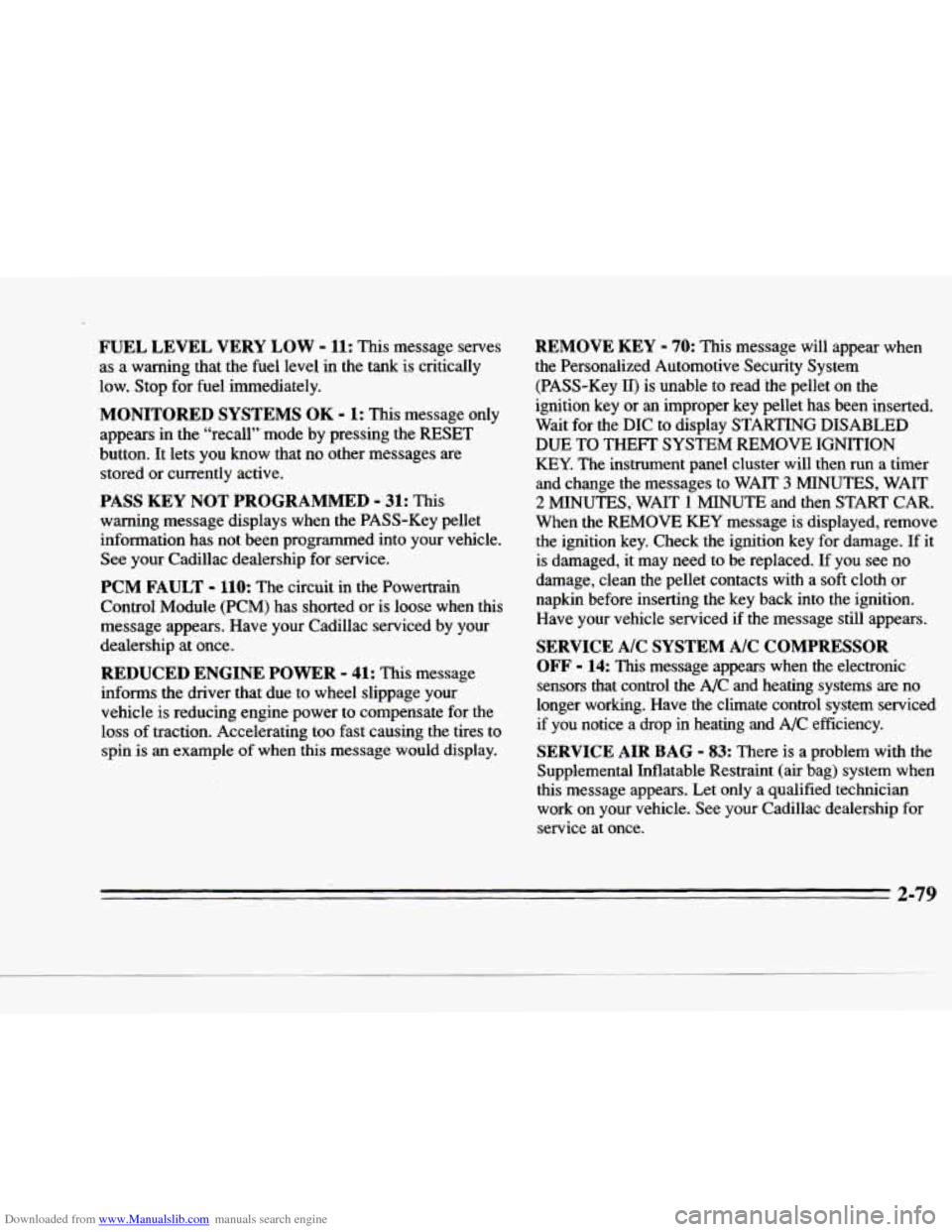
Downloaded from www.Manualslib.com manuals search engine P-
,+
c
c
FUEL LEVEL VERY LOW - 11: This message serves
as a warning that the fuel level in the tank is critically
low. Stop for fuel immediately.
MONITORED SYSTEMS OK - I: This message only
appears in the “recall” mode by pressing the
RESET
button. It lets you know that no other messages are
stored or currently active.
PASS KEY NOT PROGRAMMED - 31: This
warning message displays when the PASS-Key pellet information has not been programmed into your vehicle.
See your Cadillac dealership for service.
PCM FAULT - 110: The circuit in the Powertrain
Control Module
(PCM) has shorted or is loose when this
message appears. Have your Cadillac serviced by your
dealership at once.
REDUCED ENGINE POWER - 41: This message
informs
the driver that due to wheel slippage your
vehicle
is reducing engine power to compensate for the
loss of traction. Accelerating too fast causing the tires to
spin
is an example of when this message would display.
REMOVE KEY - 70: This message will appear when
the Personalized Automotive Security System
(PASS-Key
11) is unable to read the pellet on the
ignition key or
an improper key pellet has been inserted.
Wait for the DIC to display STARTING DISABLED
DUE TO THEFT SYSTEM REMOVE IGNITION
KEY. The instrument panel cluster will then
run a timer
and change the messages to WAIT
3 MINUTES, WAIT
2 MINUTES,. WAIT 1 MINUTE and then START CAR.
When the REMOVE
KEY message is displayed, remove
the ignition key. Check the ignition key for damage. If it
is damaged,
it may need to be replaced. If you see no
damage, clean the pellet contacts with a soft cloth
or
napkin before inserting the key back into the ignition.
Have your vehicle serviced if the message still appears.
SERVICE A/C SYSTEM A/C COMPRESSOR
OFF
- 14: This message appears when the electronic
sensors that control the A/C and heating systems are no
longer working. Have the climate control system serviced
if you notice a drop in heating and A/C efficiency.
SERVICE AIR BAG - 83: There is a problem with the
Supplemental Inflatable Restraint (air bag) system when
this message appears. Let only a qualified technician work on your vehicle. See your Cadillac dealership for
service
at once.
2-79
Page 143 of 354

Downloaded from www.Manualslib.com manuals search engine SERVICE BRAKE FLUID SWITCH - 37: A high
level of brake fluid causes this message to display if the
ignition is in the
RUN position. Have the brake system
serviced by a Cadillac technician as soon as possible.
If
the brake warning light is on, refer to the directions
listed in that 'part.
SERVICE CHARGING SYSTEM - 102: This
message will display when a problem with
the charging
system has been detected. Have your vehicle serviced at
your Cadillac dealership.
SERVICE ELECTRICAL SYSTEM - 106: This
message will display if
an electrical problem has
occurred within the PCM. Have your vehicle service by your Cadillac dealership.
SERVICE EMISSIONS SYSTEM - 104: A problem
in the emissions system has occurred when this message
appears. Have your Cadillac dealership service your vehicle.
SERVICE ENGINE COOLING SYSTEM - 103: A
problem within the engine cooling system has been
detected when this message displays. See your Cadillac
dealership
for service.
SERVICE FUEL SYSTEM - 101: The PCM
has detected a problem within the fuel system when
this message appears. See
your Cadillac dealership
for service.
SERVICE IDLE CONTROL SYSTEM - 107: A
problem with the idle control has occurred when this message displays. Bring your vehicle
to your Cadillac
dealership for service.
SERVICE IGNITION SYSTEM - 105: This
message displays when a failure in the ignition system
has been detected. Have your vehicle serviced by your Cadillac dealership.
SERVICE RIDE CONTROL - 84: This message is
displayed to indicate that the suspension system is not
operating properly.
To correct this problem have your
vehicle serviced at your Cadillac dealership.
SERVICE TRANSMISSION - 100: If a problem is
detected with the transaxle, this message will appear. Have your vehicle checked by your CadilIac dealership.
SPEED SENSOR FAULT - 109: A circuit problem with
the vehicle speed sensor will trigger this message to appear.
Have your Cadillac dealership service your vehicle.
2-80
-.
-4
Page 187 of 354

Downloaded from www.Manualslib.com manuals search engine Avoid needless heavy braking. Some people drive in
spurts
-- heavy acceleration followed by heavy
braking
-- rather than keeping pace with traffic. This is a
mistake. Your brakes may not have time to cool between
hard stops. Your brakes will wear out much faster if you
do a lot
of heavy braking. If you keep pace with the
traffic and allow realistic following distances,
you will
eliminate a lot of unnecessary braking. That means
better braking and longer brake
life.
If your engine ever stops while you’re driving, brake
normally but don’t pump your brakes. If
you do, the
pedal may get harder
to push down. If your engine
stops, you will still have some power brake assist. But
you will use it when you brake. Once the power assist is
used up, it may take longer to stop and the brake pedal
will be harder
to push.
Anti-Lock Brakes
Your vehicle has anti-lock brakes (ABS). ABS is an
advanced electronic braking system that will help
prevent a braking skid.
When you start your engine and begin to drive away,
your anti-lock brake system will check itself.
You may
hear a momentary motor or clicking noise while this test
is going on, and you may even notice that your brake
pedal moves a little. This is normal.
ANTI -
LOCK
If there’s a problem with the
anti-lock brake system, this
warning light will stay on. See “Anti-Lock Brake
System
Warning Light” in
the Index.
4-6
Page 190 of 354
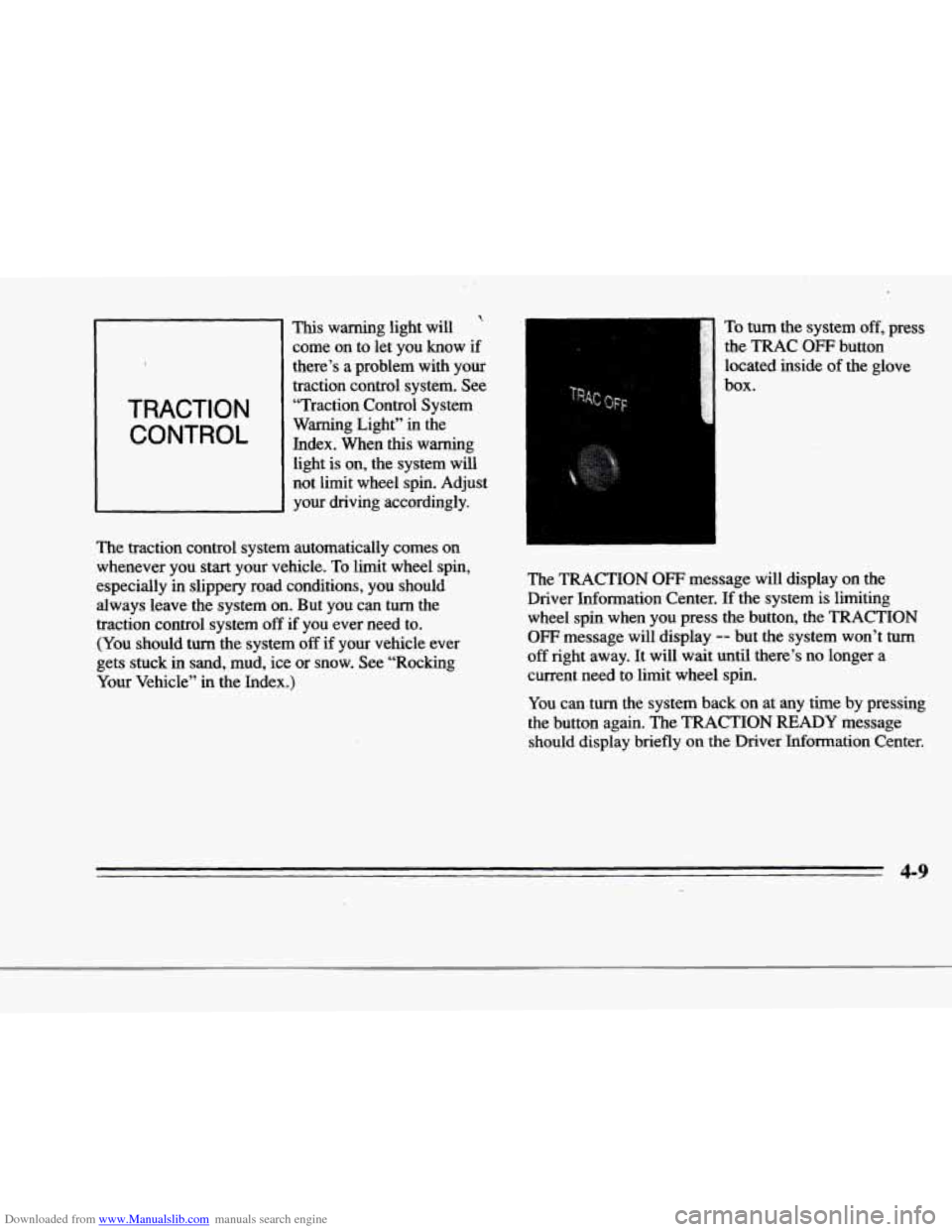
Downloaded from www.Manualslib.com manuals search engine . <.”’. ’ .:, . -. -. .
r
r
r
TRACTION
CONTROL
This warning light will
come on to let you know
if
there’s a problem with your
traction control system. See
“Traction Control System
Warning Light” in the
Index. When this warning
light is on, the system will
not limit wheel spin. Adjust your driving accordingly.
I
r
r
r
The traction control system automatically comes on
whenever you
start your vehicle. To limit wheel spin,
especially
in slippery road conditions, you should
always leave the system on.
But you can turn the
traction control system off
if you ever need to.
(You should turn the system
off if your vehicle ever
gets stuck
in sand, mud, ice or snow. See “Rocking
Your Vehicle” in the Index.)
r
r
To turn the system off, press
the
TRAC OFF button
located inside of the glove
box.
The TRACTION OFF message will display on the
Driver Information Center. If the system
is limiting
wheel spin when you press the button, the TRACTION
OFF message will display -- but the system won’t turn
off right away. It will wait until there’s no longer a
current need to limit
wheel spin.
You can
turn the system back on at any time by pressing
the button again. The TRACTION
READY message
should display briefly
on the Driver Information Center.
4-9
Page 196 of 354

Downloaded from www.Manualslib.com manuals search engine c
L
LI
Of course, traction is reduced when water, snow, ice,
gravel or other material is on the road. For safety, you’ll\
want to slow down and adjust your driving
to these
conditions.
It is important to slow down on slippery
surfaces because stopping distance will be longer and
vehicle control more limited.
While driving on a surface with reduced traction,
try
your best to avoid sudden steering, acceleration or
braking (including engine braking by shifting
to a lower
gear).
Any sudden changes could cause the tires to
slide.
You may not realize the surface is slippery until
your vehicle is skidding. Learn to recognize warning
clues
-- such as enough water, ice or packed snow on
the road
to make a “mirrored surface” -- and slow
down when you have any doubt.
Remember: Any anti-lock brake system
(ABS) helps
avoid only the braking skid.
Driving at Night
Night driving is more dangerous than day driving. One
reason is that some drivers
are likely to be impaired -- by
alcohol or
drugs, with night vision problems or by fatigue.
4-15
Page 201 of 354

Downloaded from www.Manualslib.com manuals search engine City Driving
One of the biggest problems with city streets is the
amount of traffic
on them. You’ll want to watch out for
what the other drivers are doing and pay attention to
traffic signals. Here are ways to increase your safety in city driving:
Know the best way to get to where you are going.
Get a city map and plan your trip into an unknown
part of the city just as you would for a cross-country
Try to use the freeways that rim and crisscross most
large cities. You’ll save time and energy. (See the
next part, “Freeway Driving.”)
Treat a green light as a warning signal. A trd3c light
is there because the comer is busy enough to need it.
When a light
turns green, and just before you start
to move, check both ways for vehicles that have not
cleared
the intersection or may be running the red light.
trip.
4-20